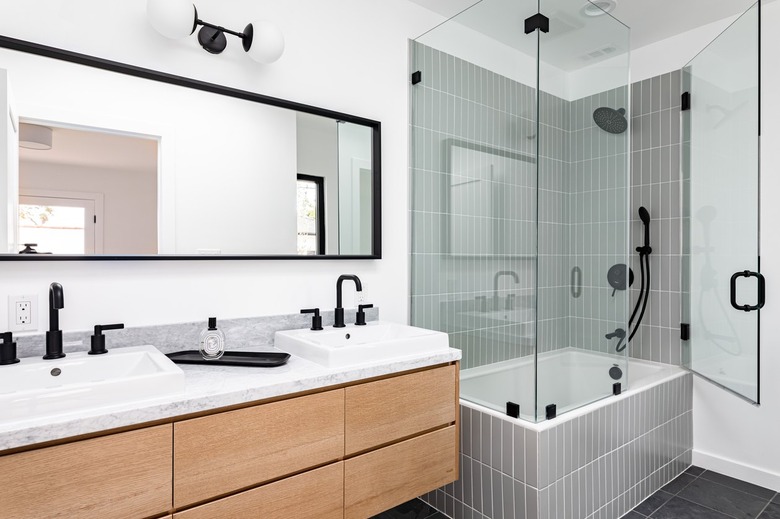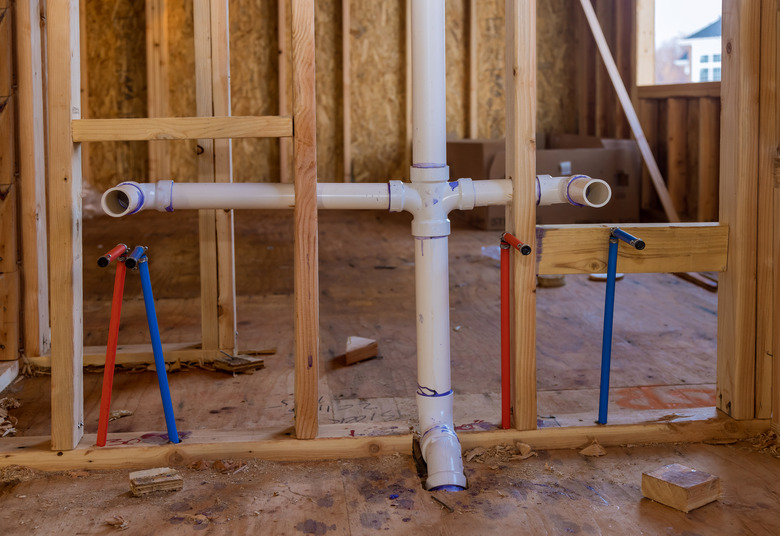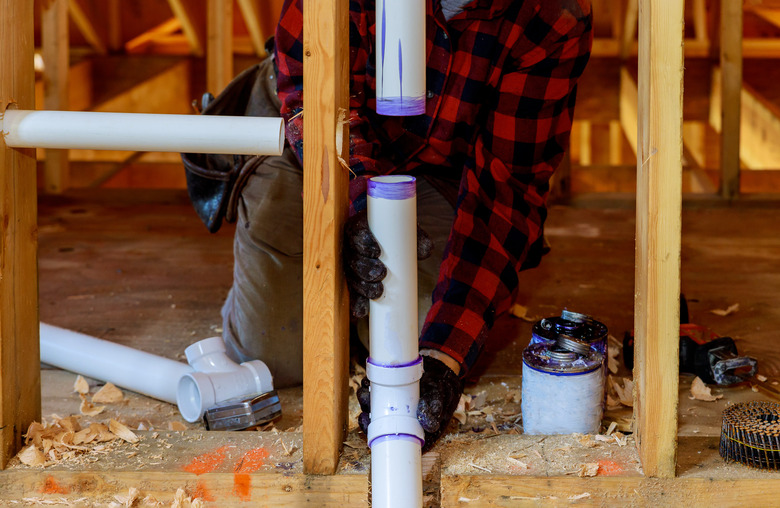Why You Should Use PVC Pipe In Your Plumbing (And Where To Use It)
We may receive a commission on purchases made from links.
Until PVC pipe became widely available to plumbers in the early 1970s, they were limited to the use of copper and galvanized steel for water supply pipes, and they had to use copper, cast iron, or a type of bituminous fiber pipe known as Orangeburg for drainpipes. The introduction of PVC plumbing pipes made a plumber's life a whole lot easier and greatly reduced the costs of water and drain installations. These days, PVC isn't the only type of plastic pipe available, but it's still one of the most commonly used for several reasons.
Plumbers like PVC pipe because it's so easy to work with. You can cut it with a hacksaw, and you join it with easy-to-apply solvent cement (after first applying a primer). Unlike metal pipe materials, such as copper and galvanized steel, PVC won't corrode, so you don't have to worry about restricted water flow or pinhole leaks. To top it off, PVC is the least expensive pipe material on the market. It's even cheaper than PEX pipe, a competing plastic material that is also commonly used today.
Despite its advantages as a material for potable water supply pipes (aka pipes that deliver drinking water), plumbers tend to use PVC more often for drainpipes than water lines. One of the reasons for this is the tendency of PVC to soften and warp when the water temperature exceeds 140 degrees Fahrenheit. It also degrades in direct sunlight and isn't suitable for above-ground exterior applications, although there are workarounds for this. PVC pipe is cheap and available everywhere, so it's a good idea to familiarize yourself with this cost-effective pipe material so you know when to choose it for your DIY plumbing project.
A Short History of PVC Pipe
A Short History of PVC Pipe
Polyvinyl chloride (PVC) was first discovered in the 19th century, but it wasn't used in manufacturing until the 1920s, when BFGoodrich scientist Waldo Semon developed it as an alternative to natural rubber, which was becoming increasingly costly. At first, it was used in limited applications, such as shoe heels, golf balls, and raincoats, but during World War II, it proved to be a superior insulating material for electrical wires, and both during and after the war, its use exploded.
The Germans were the first to manufacture PVC water and waste pipes, and many of the pipes they installed in 1936 are still in service. North American manufacturers, such as Charlotte Pipe, first started producing PVC pipes in 1952. The first PVC waste and water distribution networks were installed in 1955, and the first national standards regulating the use of PVC pipe and fittings appeared in the early 1960s. Plumbers started using it widely in the 1970s, and since then, it has been a mainstay in the plumbing industry for cold water delivery and waste applications.
Although PVC pipe isn't suitable for hot water applications, a related product is. Chlorinated polyvinyl chloride (CPVC) is produced by adding chlorine to a polyvinyl chloride slurry and irradiating it with ultraviolet light. The treatment, first introduced in 1959, produces a more durable version of PVC that can withstand temperatures up to 200 degrees Fahrenheit. Unlike PVC water pipe, which is typically white, CPVC pipe is cream-colored and is the material you should use if you're installing or repairing residential water lines.
When to Use PVC Pipe
When to Use PVC Pipe
PVC pipes are cheaper and easier to use than copper pipes, which continue to be the gold standard for residential water applications (although PEX is giving copper a run for its money). Because you can't use PVC for hot water, however, it's better to use CPVC pipes for both hot and cold water supply lines. If you're installing underground plumbing for an irrigation system, PVC pipes are an economical and practical choice, although you should protect exposed portions from sunlight and freezing temperatures by covering them with pipe insulation.
The best use of PVC is for drain and vent pipes. They are obviously easier to use than cast iron or copper drainpipes, which are no longer a practical option, but they have competition in the form of ABS (acrylonitrile butadiene styrene), a type of plastic pipe material that is black instead of white. ABS and PVC are equally suitable for drain, waste, and vent (DWV) applications under most conditions, but the choice between them may not be yours to make. Some communities require one or the other, so it's important to check.
Comparing ABS and PVC
Comparing ABS and PVC
ABS and PVC pipe and fittings are comparable in performance and cost about the same. Both are resistant to chemicals and corrosion and easily last for 50 or more years. Both are equally easy to install, although gluing PVC is a two-step process because you must apply both a primer and a PVC-solvent cement, whereas ABS pipe requires only ABS cement. PVC pipe is a bit more flexible than ABS, but ABS is stronger and better able to resist impact.
One of the main differences between them is that unlike PVC, ABS contains bisphenol A (BPA), a chemical that has raised health concerns. This isn't a major issue when it comes to waste pipes, but considering that the Food and Drug Administration regulates BPA in food containers, it is something of which the environmentally conscious DIY plumber should be aware. Another important difference is that PVC does not transmit sound as much as ABS, so if you prefer to minimize gurgling sounds when someone flushes a toilet, choose PVC waste pipes.
PVC and ABS pipes should generally not be mixed in the same DWV network, but if you want to add PVC to an ABS network or vice versa, it is possible to do so by using a mechanical connector as the junction between the two dissimilar pipes. This is typically made of rubber, and you secure it to the pipes with clamps. Joining PVC and ABS pipe with solvent cement is possible but is not recommended and may be prohibited by the local plumbing code.
Schedule 40 vs. Schedule 80
Schedule 40 vs. Schedule 80
When shopping for PVC pipe, you'll come across two types of pipes: schedule 40 and schedule 80. These designations, which are imprinted on the pipe walls, refer to the wall thickness. Schedule 80 pipes have thicker walls than schedule 40 ones. The extra thickness is added to the inside of the pipe; both types have the same outside diameter.
Because DWV pipes don't carry pressurized water, you seldom need the extra strength of schedule 80 piping material. Even in residential water supply applications, schedule 40 pipes are strong enough for most purposes. Schedule 80 pipes, which are slightly more expensive, are generally reserved for commercial and industrial applications.
Installing PVC Pipes Is Easy
Installing PVC Pipes Is Easy
Copper and steel pipes haven't gone away, so professional and DIY plumbers still have to make screw-fit and solder connections, but they have to do them less often now that PVC pipe is on the scene. You connect PVC and CPVC pipe and fittings with a solvent cement, which actually melts the plastic at the junction, allowing the pipe to fuse to the fitting and almost instantaneously form a watertight, permanent connection. It's difficult to make a bad connection, but it's possible, and considering you won't get a second chance, it's important to follow some best practices:
- Cut the pipe straight. You can cut PVC pipe with any type of saw, but the best way to ensure you get a straight cut is to use a PVC pipe cutter. If you use a saw, be sure to deburr the edges of the pipe with sandpaper or a file.
- Always use primer. PVC primer is a thin purple liquid that comes in a can with its own brush. Apply it liberally to both the pipe and the fitting. It removes greases, oils, and other extraneous substances from the plastic to ensure good adhesion.
- Apply PVC cement liberally. Like primer, PVC cement comes in a can with its own brush. You should also apply this liberally (but avoid creating pools of cement) to both the pipe and the fitting, but before you do, orient the pipe so it's ready to go into the fitting immediately after you apply the cement, which has a very short open time.
- Make the connection quickly. Push the pipe into the fitting as far as it will go and give the pipe a little twist. Maintain pressure on the pipe for several seconds to prevent it from slipping out while the cement is still wet.
When connecting pressurized PVC or CPVC water supply pipes, it's prudent to wait for at least 10 minutes before turning on the water.
PVC Bushings and Adapters
PVC Bushings and Adapters
When installing PVC drain lines, you'll have occasion to change pipe diameter. For example, the 1 1/2-inch PVC drainpipe from a bathroom sink typically connects to a 2-inch waste line, which in turn feeds into a 3- or 4-inch main house drain or sewer pipe. The PVC fittings you use to make these transitions are bushings, which slip inside the larger pipe and have a smaller-diameter aperture, or bell reducers, which fit over the pipes.
You can connect PVC and CPVC pipes to other types of pipes, including copper and steel ones, with screw-on adapters. When connecting to copper pipe, you first solder a threaded adapter onto the copper pipe and then you screw on a PVC adapter that has a slip connection for the PVC pipe. Always wrap plumbing tape around the male threads to ensure a leak-free connection.
Galvanized steel pipes already have threads, but you should convert male threads to female with a coupling before screwing on a PVC slip adapter. Male-threaded PVC adapters are less likely to crack and leak when tightening them down than female ones.
References
- How to Look at a House: What Type Water Supply and Drain (DWV) Pipes Were Commonly Used for 1960s Residential Plumbing?
- The History of Sanitary Sewers: Milestones in PVC Water Pipe History
- Commercial Industrial Supply: ABS vs. PVC Piping – Differences and Common Uses
- Accurate Leak and Line: The Importance of PVC Pipes
- Plastic Pipe and Fittings Association: Polyvinyl Chloride (PVC)
- Benjamin Franklin: What's the Difference Between ABS and PVC Pipe?


